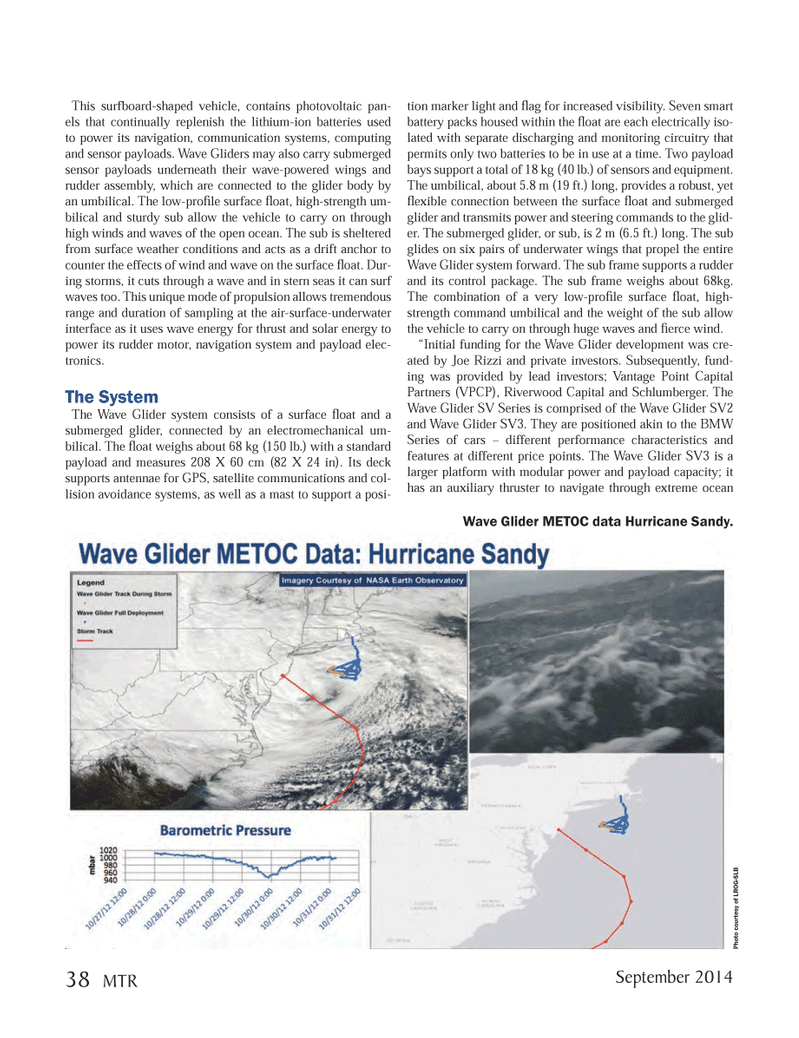
Page 38: of Marine Technology Magazine (September 2014)
Ocean Observation: Gliders, Buoys & Sub-Surface Networks
Read this page in Pdf, Flash or Html5 edition of September 2014 Marine Technology Magazine
This surfboard-shaped vehicle, contains photovoltaic pan- els that continually replenish the lithium-ion batteries used to power its navigation, communication systems, computing and sensor payloads. Wave Gliders may also carry submerged sensor payloads underneath their wave-powered wings and rudder assembly, which are connected to the glider body by an umbilical. The low-profi le surface fl oat, high-strength um- bilical and sturdy sub allow the vehicle to carry on through high winds and waves of the open ocean. The sub is sheltered from surface weather conditions and acts as a drift anchor to counter the effects of wind and wave on the surface fl oat. Dur- ing storms, it cuts through a wave and in stern seas it can surf waves too. This unique mode of propulsion allows tremendous range and duration of sampling at the air-surface-underwater interface as it uses wave energy for thrust and solar energy to power its rudder motor, navigation system and payload elec- tronics.
The System
The Wave Glider system consists of a surface fl oat and a submerged glider, connected by an electromechanical um- bilical. The fl oat weighs about 68 kg (150 lb.) with a standard payload and measures 208 X 60 cm (82 X 24 in). Its deck supports antennae for GPS, satellite communications and col- lision avoidance systems, as well as a mast to support a posi- tion marker light and fl ag for increased visibility. Seven smart battery packs housed within the fl oat are each electrically iso- lated with separate discharging and monitoring circuitry that permits only two batteries to be in use at a time. Two payload bays support a total of 18 kg (40 lb.) of sensors and equipment.
The umbilical, about 5.8 m (19 ft.) long, provides a robust, yet fl exible connection between the surface fl oat and submerged glider and transmits power and steering commands to the glid- er. The submerged glider, or sub, is 2 m (6.5 ft.) long. The sub glides on six pairs of underwater wings that propel the entire
Wave Glider system forward. The sub frame supports a rudder and its control package. The sub frame weighs about 68kg.
The combination of a very low-profi le surface fl oat, high- strength command umbilical and the weight of the sub allow the vehicle to carry on through huge waves and fi erce wind. “Initial funding for the Wave Glider development was cre- ated by Joe Rizzi and private investors. Subsequently, fund- ing was provided by lead investors; Vantage Point Capital
Partners (VPCP), Riverwood Capital and Schlumberger. The
Wave Glider SV Series is comprised of the Wave Glider SV2 and Wave Glider SV3. They are positioned akin to the BMW
Series of cars – different performance characteristics and features at different price points. The Wave Glider SV3 is a larger platform with modular power and payload capacity; it has an auxiliary thruster to navigate through extreme ocean
Photo cour tesy of LR
OG-SLB
Wave Glider METOC data Hurricane Sandy.
September 2014 38 MTR
MTR #7 (34-49).indd 38 8/27/2014 9:32:40 AM

 37
37

 39
39
